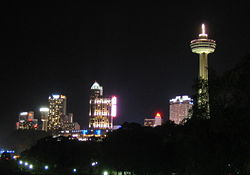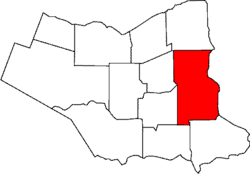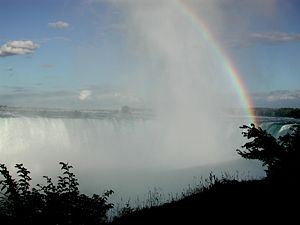Niagara Falls, Ontario
| City of Niagara Falls, Ontario | |
 |
|
| Nickname(s): The Honeymoon Capital of the World | |
 |
|
| Coordinates: | |
| Country | Canada |
|---|---|
| Province | Ontario |
| Region | Niagara |
| Incorporated | June 12, 1903 |
| Government | |
| - Mayor | Ted Salci |
| - Governing body | Niagara Falls City Council |
| - MP | Rob Nicholson |
| - MPP | Kim Craitor |
| Area [1][2] | |
| - City | 209.58 km² (80.9 sq mi) |
| - Urban | 382.68 km² (147.8 sq mi) |
| - Metro | 1,397.50 km² (539.6 sq mi) |
| Population (2006)[1][2] | |
| - City | 82,181 (Ranked 60th) |
| - Density | 392.14/km² (1,015.6/sq mi) |
| - Urban | 308,596 (Ranked 12th) |
| - Urban Density | 545.02/km² (1,411.6/sq mi) |
| - Metro | 390,317 (Ranked 12th) |
| - Metro Density | 279.3/km² (723.4/sq mi) |
| Time zone | EST (UTC-5) |
| - Summer (DST) | EDT (UTC-4) |
| Postal Code | L2E-L2J, L0S |
| Area code(s) | 905/289 |
| Website: [2] | |

Niagara Falls is a Canadian city of 82,184 residents[1] on the Niagara River in the Golden Horseshoe region of south-central Ontario. It lies across the river from Niagara Falls, New York, and was incorporated on June 12, 1903.
The city is dominated by Niagara Falls, a world famous set of two large waterfalls on the Niagara River and benefits from the fact that both falls, the American and Horseshoe, can be best seen from the Canadian side of the river, thus presenting the city one of the major tourist attractions of the world. The natural spectacle brings in millions of tourists yearly. The city permitted the development of a tourist area along the falls and the gorge. This area which stretches along the Niagara River parkway and tourist promenade is particularly concentrated at the brink of the falls and, apart from the natural attractions along the river, includes huge parking lots, souvenir shops, observation towers, high-rise-hotels, casinos and theatres, mostly with colourful neon billboards and advertisements. Further to the north or south there are golf courses alongside historic sites from the War of 1812.
Contents |
History
The Niagara Falls area has seen continuous settlement since the 17th century, first by the Iroquois and then by Europeans who were drawn to the immense falls. Louis Hennepin, a French priest, is regarded as the first European to visit the area in the 1670s.
Tourism started in the early 19th century and has been a vital part of the local economy since that time. As well as the obvious attractions of the falls, Niagara Falls markets itself as a honeymoon destination and is self-proclaimed as the honeymoon capital of the world. In 1953, Marilyn Monroe filmed Niagara (1953 film), a major event for the city.
With the creation of a Niagara regional government in 1970, the city amalgamated with the village of Chippawa and surrounding Willoughby, Crowland, and Stamford Townships, creating the present-day municipal boundaries.
The City's Official Historian is Sherman Zavitz, who gives regular radio broadcasts on many aspects of Niagara's history [3].
Geography and Climate
Niagara Falls, Ontario is 130 kilometers (81 mi) from Toronto by road. The area of the Niagara Region is 1800 square kilometers (718 sq mi). The city sits at .
Topography
The city is built along the Niagara Falls waterfalls and the Niagara Gorge on the Niagara River which flows from Lake Erie to Lake Ontario.
Climate
The weather and climate for the Niagara Region of Ontario is moderate to extreme in both summer and winter. There are considerable extremes in either temperature or the type of weather that might be associated with locations that are in close proximity to a landmass such as the bodies of water surrounding the region.[4]
| Niagara Falls climate normals from Environment Canada[4] | Jan | Feb | Mar | Apr | May | Jun | Jul | Aug | Sep | Oct | Nov | Dec |
|---|---|---|---|---|---|---|---|---|---|---|---|---|
| Avg. temp. (°C) | -4.5 | -4.1 | 1 | 7.3 | 14 | 19.1 | 22.3 | 21.4 | 16.9 | 10.6 | 4.7 | -1.4 |
| Avg high temp. (°C) | -1 | -0.5 | 5.1 | 12.2 | 19.3 | 24.2 | 27.2 | 26 | 21.3 | 14.7 | 8 | 1.9 |
| Avg low temp. (°C) | -7.9 | -7.7 | -3.2 | 2.4 | 8.6 | 13.9 | 17.2 | 16.7 | 12.5 | 6.4 | 1.3 | -4.7 |
| Precipitation (millimeters) | 69.5 | 67.4 | 75.5 | 75.5 | 76.5 | 87.5 | 75.4 | 81.6 | 95.2 | 84.3 | 91 | 90.7 |
Demographics
| Ethnic Origin | Population | Percent |
|---|---|---|
| English | 22,880 | 29.32% |
| Italian | 15,425 | 19.77% |
| Scottish | 13,910 | 17.82% |
| Irish | 11,200 | 14.35% |
| French | 8,710 | 11.16% |
| Source: 2001 Census of Canada[5] | ||
In 2006, the population of Niagara Falls was 82,184 persons[3], an increase of 4.3 percent from the previous 2001 census, slightly below national growth, while the metropolitan area enumerated 427,421 people. The population of Niagara Falls is older than Canada in general in terms of age structure. Youths under 14 years of age number 18.09%, while those of retirement age number 17.03% showing a continuous ageing trend. Some 5,130 (6.57%) inhabitants described themselves visible minorities (non-white/non-European)[4].
83.97% of Niagara Falls city residents self-identified with Christian denominations. The largest denominations consist of Catholic (41.99%), Protestant (36.80%), and 5.18% other Christian mostly Orthodox, 14.10% claimed no religious affiliation, while minor religions (1.93%) including Jewish, Buddhist, Hindu, and Muslim accounted for the rest.[6]
Communities
- Chippawa
- Crowland
- Niagara Falls
- Silvertown
- Stamford
- Willoughby
Niagara Falls Neighbourhoods
- Caliguiro Estates
- Cherrywood Acres
- Clifton Hill
- Corwin Crescent
- Dorchester Village
- Downtown
- Drummond Heights
- Drummondville
- Fallsview
- Glenview
- Lascala
- Lundy's Lane
- Mount Carmel
- River Road
- Rolling Acres
- Royal
- Scott
- Stamford Village
- Queen Street Arts & Culture District
Business and Tourist Centers
- Clifton Hill District
- Fallsview
- Lundy's Lane
Economy
With a plentiful and inexpensive source of hydroelectric power via the waterfalls, many electro-chemical and electro-metallurgical industries located here in the early to mid-20th century.
Industry began moving out of the city in the 1970s and 80s because of recession and increasing global competition in the manufacturing sector. Tourism tightened its grip as the city's most important economic engine. It is a more popular destination than Niagara Falls, New York, in part due to the better view of the falls from the Canadian side. Also, Ontario's drinking age of 19 (compared to the 21 drinking age in the United States) attracts many 19 and 20-year-olds from the United States to the bars on the Canadian side.
In the mid-1990s the Ontario government introduced legal wagering to the local economy with Casino Niagara. The late-1990s witnessed an economic boom as numerous luxury hotels and tourist attractions were built. The first casino was followed in 2004 by the larger Niagara Fallsview Casino Resort. Upon launching, the casino business was successful in attracting American tourists due to the then lower Canadian dollar. However, with a United States Dollar lower than parity, the Seneca Niagara Casino on the American side, and a casino facility coming to Buffalo, New York, as well as impending passport requirements on the American side, the local tourist economy is not without potential problems.
The recent development has been almost completely centred on the Clifton Hill and Fallsview areas. The Niagara Falls downtown is undergoing a major revitalization process, this area is being developed into a arts and culture district. The downtown was a major centre for local commerce and night life up until the 1970s, when the development of the Niagara Square (mall) began to draw away crowds and retailers. In 2006, New York City based developer Aaron Lichtman proposed a major investment in the area to encourage new retail development; the proposal, titled Historic Niagara, remains dependent on government funding of complementary services. Since then Historic Niagara has brought art galleries, boutiques, cafes and bistros to the street and includes the renovation of the Seneca Theatre.
Government
Niagara Falls City Council consists of 8 councilors and 1 Mayor. City elections take place every 4 years with the next election in November 2010. Council is responsible for policy and decision making, monitoring the operation and performance of the city, analyzing and approving budgets and determining spending priorities.
Education
Niagara Falls has two post-secondary institutions as well is served by the District School Board of Niagara and the Niagara Catholic District School Board which operate elementary and secondary schools in the region. There are also numerous private institutions offer alternatives to the traditional education systems.
Post Secondary
- Brock University in St. Catharines
- Niagara College in Welland, with campuses in Niagara Falls and Niagara-on-the-Lake.
High Schools
- Saint Michael Catholic High School
- Westlane Secondary School
- Stamford Collegiate
- A N Myer Secondary School
- Saint Paul Catholic High School
Library
Niagara Falls is also served by a growing library system composed of four branches, with the main branch located in the downtown area. It is visited by over 10,000 people weekly. The Niagara Falls Public Library system's goals include preserving and indexing public materials relating to the history of Niagara Falls. An extensive online database exists with over 20,000 photographs and art works at Historic Niagara Digital Collections
Sites of Interest

The Niagara Falls, Ontario tourist district is mainly centred around the waterfalls. Much of the land adjoining the river is parkland under the jurisdiction of the Niagara Parks Commission. Many attractions based on the local natural environment have been created. To prolong visitor stays the city of Niagara Falls has a number of additional attractions in close proximity but not related to the natural features, including casinos and entertainment complexes. One new attraction, located in the Table Rock Center at the brink of the Horseshoe Falls, is called Niagara's Fury and is a representation of how the Falls were created. The attraction creates a simulated ice age environment where the visitor is able to feel rain and snow fall, as well as experience a rapid temperature drop. The Niagara Peninsula is also a significant wine-growing area, with winery tours and festivals becoming a significant area of growth in the local economy.The Canadian side of Niagara Falls has more attractions.
- Maid of the Mist
- Journey Behind the Falls
- Skylon Tower observation deck
- Weekly fireworks over Niagara Falls
- Nightly illumination of Niagara Falls
- National Helicopters
- Niagara Helicopters
- Niagara Skywheel
- Queen Street Arts & Culture District
Niagara River and parkway attractions
- Niagara Botanical Gardens
- Floral Clock
- Spanish Aerocar over the Niagara River whirlpool
- White Water Walk at the Niagara River rapids
- Winter Festival of Lights
- Butterfly conservatory
- Niagara Heritage Trail
- Dufferin Islands
- Niagara Parks School of Horticulture

- Niagara River Recreation Trail
- Whirlpool Jetboat tours of the Niagara Gorge
- Numerous parkway golf courses
- The Rainbow Carillon, which sounds from the Rainbow Tower
Tourist sector entertainment
- Clifton Hill, Niagara Falls — Tourist promenade featuring many arcades, haunted houses, wax museums, and themed restaurants.
- Falls Avenue Entertainment Complex — 20 acre property featuring attractions, themed restaurants and hotels.
- Marineland — Aquatic theme park
- Casinos-- Casino Niagara and Niagara Fallsview Casino Resort
- Major theme restaurants including Planet Hollywood[5], Rainforest Cafe[6] and the Hard Rock Café[7]
- IMAX[www.imaxniagara.com] Theatre and daredevil museum
- Greg Frewin Theatre / Las Vegas style magic show.
- Skylon Tower[8] - Revolving dining towering 774 feet above Niagara gorge.
- Fallsview Tourist Area
- WWE Niagara Falls[9] - World Wrestling Entertainment Store and Ride
- Fallsview Indoor Waterpark[10]
- MGM Studios Plaza[11]
- Queen Street Arts & Culture District [12]
Transportation
Highways
Niagara Falls and Niagara Falls, New York are linked to major highways in Canada and the United States respectively, with the 400-Series highway the Queen Elizabeth Way acting as a major artery between Toronto, Ontario and Buffalo, New York. Highway 420 is also another highway in the city. Niagara Parkway is a road operated under the Niagara Parks Commission.
Regional airports
- Buffalo Niagara International Airport in Cheektowaga, New York.
- Toronto Pearson International Airport in Mississauga, Ontario.
- Hamilton/John C. Munro International Airport in Mount Hope, Ontario.
- Niagara Falls International Airport in Niagara Falls, New York
- Niagara District Airport in Niagara on the Lake, Ontario.
Shuttle bus services connect the city with all three airports.
Rail
- VIA Rail runs out of the Niagara Falls station, and in the summers offers a bike train service on a limited schedule.
- Amtrak also has trains connecting it to Toronto and New York City
Bus
- Niagara Transit is the public transit operator in the city.
- Greyhound Canada has daily runs to and from Toronto and Buffalo, New York.
- Coach Canada has daily runs to and from Toronto and Buffalo, New York.
Cabs and shuttlebuses
- Niagara Livery Service is a shuttle bus operator for Casino Niagara.
- 5-0 is a local cab service. A taxi shuttle provides transfers to airports from Buffalo, New York to Niagara Falls, Ontario and Toronto, Ontario.
- Niagara Falls Taxi is another local taxi cab service that has a niche in mass taxing from the Buffalo, New York and Toronto, Ontario airports back to Niagara.
Media
Niagara Falls is served by two main local newspapers, three radio stations and a community television channel. All other media is regional based, as well from Hamilton, Toronto and nearby Buffalo, New York.
Niagara Falls is considered part of the Toronto television market rather than the Buffalo television market. While Niagara Falls is directly across the Niagara River from the American side of the Buffalo area, Toronto is an hour and a half northwest. However, it is considered part of the Buffalo radio market.
Newspapers
Due to its proximity to Toronto and Buffalo, the local media is dominated by Toronto and Buffalo outlets. Local residents have easy access to the papers like the Toronto Star and the Toronto Sun. The Buffalo News is also widely available.
Local newspapers are:
Radio
- 710 AM - CJRN, "710 CJRN" Tourist information
- 101.1 FM - CKEY, "Z101" urban CHR
- 105.1 FM - CFLZ, "105.1 The River" hot adult contemporary
Television
- TV Cogeco is a community channel serving Niagara Falls.
- CIII-TV (VHF channels 3 & 6, UHF channels 33 & 55), a Global transmitter from nearby Fort Erie.
- CHCH from Hamilton, Ontario and serves the Niagara Region.
Sports
| Club | League | Sport | Venue | Established | Championships |
|---|---|---|---|---|---|
| Niagara Falls Canucks | Golden Horseshoe Junior B Hockey League | Hockey | Niagara Falls Memorial Arena | 1979 |
2 |
| Niagara IceDogs | Ontario Hockey League | Hockey | Gatorade Civic Center | 2007 |
2 |
Notable People From Niagara Falls
- Jay Triano - Toronto Raptors Interim Head Coach & former Captain and later Head Coach of the Canadian National Men's Basketball team
- Daneen Boone - actress
- Billy Cupolo - former NHLer
- Stephan Moccio - Musician, Arranger, Composer
- James Cameron - Director
- Eddie Greenspan - Lawyer
- Brian Greenspan - Lawyer
- Gord Singleton - Olympic cyclist
- Barbara Frum - television journalist
- Derek Sanderson - NHL player
- Rob Nicholson - Minister of Justice and Attorney General for Canada
- Sherman Zavitz - Historian
- Frank Pietrangelo - Former NHL Goalie. Known for "The Save" with the Pittsburgh Penguins during the 1991 Stanley Cup Playoffs.
References
- ↑ 1.0 1.1 1.2 "Community Highlights, City of Niagara Falls". Statistics Canada, 2006 Census of Population (2007-03-13). Retrieved on 2007-03-17.
- ↑ 2.0 2.1 "St. Catharines-Niagara Census Metropolitan Area (CMA) with census subdivision (municipal) population breakdowns, land areas and other data". Statistics Canada, 2006 Census of Population (2007-03-13). Retrieved on 2007-03-17.
- ↑ Sherman Zavitz, 'Niagara Falls History',[1]
- ↑ 4.0 4.1 "Canadian Climate Normals 1971–2000, Niagara Falls, Ontario". Environment Canada (2004-02-25). Retrieved on 2007-03-23.
- ↑ "Selected Ethnic Origins, for Census Subdivisions (Municipalities) With 5,000-plus Population - 20% Sample Data". Statistics Canada, 2001 Census of Population. Retrieved on 2007-03-17.
- ↑ "Community Highlights, City of Niagara Falls". Statistics Canada, 2001 Census of Population (2007-01-02). Retrieved on 2007-03-17.
External links
- Official website of the City of Niagara Falls
- Official map site of the City of Niagara Falls
- Niagara Falls Community Newspaper
- Some old postcards of Niagara.
- Niagara Falls, Ontario, from The Canadian Encyclopedia
 |
St. Catharines | Lake Ontario Niagara-on-the-Lake |
Lewiston, NY |
|
|||
| Thorold | Niagara Falls, NY | ||||||
| Welland Port Colborne |
Fort Erie Crystal Beach Lake Erie |
Buffalo, NY |
|
|||||